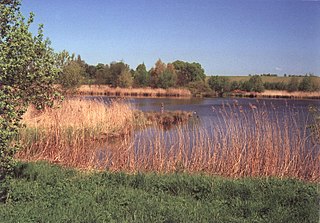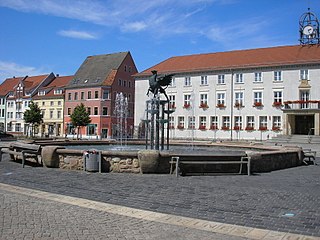
The Lemovii were a Germanic tribe, only once named by Tacitus in the late 1st century. He noted that they lived near the Rugii and Goths and that they had short swords and round shields.

Demmin is a town in the Mecklenburgische Seenplatte district, Mecklenburg-Western Pomerania, Germany. It was the capital of the former district of Demmin.

Jarmen is a town in the Vorpommern-Greifswald district, in Mecklenburg-Western Pomerania, Germany. It is situated on the southern bank of the river Peene, 20 km south of Greifswald. Founded during the Ostsiedlung in the medieval terrae Miserez and Ploth, Jarmen remained a rural town at an important Peene crossing. Jarmen was in the Duchy of Pomerania from its foundation until the Thirty Years' War, in Swedish Pomerania until the Great Northern War, in Prussian Pomerania until World War II, in the East German state of Mecklenburg-Vorpommern and later Bezirk Neubrandenburg until the peaceful revolution in 1989 and in the state of Mecklenburg-Vorpommern within reunited Germany since 1990. The Autobahn 20 crosses the Peene at Jarmen.

The Treaty of Templin was concluded on 24/25 November 1317, ending a war between the Margraviate of Brandenburg and Denmark, the latter leading a North German alliance. During this war, Brandenburgian margrave Waldemar and his troops were decisively defeated in the 1316 Battle of Gransee, fought at Schulzendorf between Rheinsberg and Gransee. After the battle, Brandenburg was forced to negotiate a truce. The treaty of Templin was signed a year later by Danish king Erich VI Menved, his ally duke Henry II of Mecklenburg, and Waldemar.
The County of Gützkow was a part of the Duchy of Pomerania during the High Middle Ages (1219–1359), named after the central town of Gützkow and stretching roughly from the Peene River in the South to the Ryck River in the North. It emerged from the earlier Liutician Principality of Gützkow, that was turned into a castellany when subdued by the Dukes of Pomerania. When the last Count of Gützkow died in 1359, the area was turned into a Vogtei, which was merged into Amt Wolgast in the beginning 16th century.

Pomerania during the Early Middle Ages covers the History of Pomerania from the 7th to the 11th centuries.
The Gustow group is an archaeological culture of the Roman Iron Age in Western Pomerania. The Gustow group is associated with the Germanic tribe of the Rugii.

Groswin was the name-giving seat of one of the castellanies of the Duchy of Pomerania in the High Middle Ages. It was located in Western Pomerania near modern Anklam.

In the area of present-day Mecklenburg-Vorpommern, Germany, up to 5,000 megalith tombs were erected as burial sites by people of the Neolithic Funnelbeaker (TRB) culture. More than 1,000 of them are preserved today and protected by law. Though varying in style and age, megalith structures are common in Western Europe, with those in Mecklenburg-Vorpommern belonging to the youngest and easternmost—further east, in the modern West Pomeranian Voivodeship of Poland, monuments erected by the TRB people did not include lithic structures, while they do in the south (Brandenburg), west and north (Denmark).

The Groß Raden Archaeological Open Air Museum lies a few kilometres north of the small town of Sternberg and about a kilometre northeast of the village of Groß Raden in the German state of Mecklenburg-Vorpommern. The site is in a depression that borders directly onto the lake of Radener See. On a peninsula in front of that lies its circular castle rampart, visible from afar, which has a diameter of 50 metres. From 1973 to 1980 extensive excavations were carried out here, led by Ewald Schuldt, during the course of which the remnants of a Slavic settlement dating to the 9th and 10th centuries was unearthed. The fort has been reconstructed based on the excavations and established as an archaeological open-air museum. It has been enhanced by finds from the Slavic castle of Behren-Lübchin.

The great dolmen or grand dolmen is a type of megalithic site of the Funnelbeaker culture (TBK) that occurs in Nordic megalith architecture, primarily in the east of what is now German Mecklenburg-Vorpommern, and which has two different types of entrance. Neolithic monuments are features of the culture and ideology of Neolithic communities. Their evolution and function act as indicators of social development. The type of site, called Stordysse in Danish, does not follow the criteria listed below. In Germany, dolmens with three or more capstones are described as great dolmens and are divided into:

Nordic megalith architecture is an ancient architectural style found in Northern Europe, especially Scandinavia and North Germany, that involves large slabs of stone arranged to form a structure. It emerged in northern Europe, predominantly between 3500 and 2800 BC. It was primarily a product of the Funnelbeaker culture. Amongst its researchers, Ewald Schuldt in Mecklenburg-Western Pomerania excavated over 100 sites of different types - simple dolmens, extended dolmens – also called rectangular dolmens – passage graves, great dolmens, unchambered long barrows and stone cists - between 1964 and 1974. In addition, there are polygonal dolmens and types that emerged later, for example, the Grabkiste and Röse. This nomenclature, which specifically derives from the German, is not used in Scandinavia where these sites are categorised by other, more general, terms, as dolmens, passage graves and stone cists . Neolithic monuments are a feature of the culture and ideology of Neolithic communities. Their appearance and function serves as an indicator of their social development.
Ewald Schuldt, full name Ewald Adolf Ludwig Wilhelm Schuldt, was a German prehistorian who carried out significant research into the megaliths of northern Germany.

The polygonal dolmen is a visually very attractive megalithic architectural structure and is therefore often depicted as the archetypal dolmen. It is encountered especially frequently in the north of the Danish island of Zealand, in the Swedish province of Bohuslän and on the Cimbrian Peninsula, for example, at Troldkirken in Jutland. In Schleswig-Holstein, there are 11 examples. In Lower Saxony, Mecklenburg-Western Pomerania and Saxony-Anhalt (Lüdelsen) they appear are only occasionally.

The various types of megalithic monuments in northeastern Germany were last compiled by Ewald Schuldt in the course of a project to excavate megalithic tombs from the Neolithic Era, which was conducted between 1964 and 1972 in the area of the northern districts of East Germany. His aim was to provide a "classification and naming of the objects present in this field of research". In doing so it utilised a classification by Ernst Sprockhoff, which in turn was based on an older Danish model.

The Opfermoor Vogtei is an open-air museum at the location of a prehistoric and protohistoric sacrificial bog in the municipality of Vogtei, Thuringia, in Germany. It lies within the former municipality of Oberdorla, approximately 200 metres (220 yd) from Niederdorla, and the site is also known by those names.
The Salzmünde Group or Salzmünde Culture is the name for a late group from the Funnelbeaker culture in central Saale-Elbe region of Germany, which existed between 3400 and 3000 BC during the Neolithic period.





















